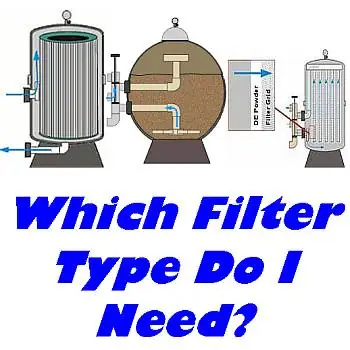There are basically 3 types of pool filters: Sand Filter, Cartridge Filter and Diatomaceous Earth Filters (DE Filters for
short). Each of these have their pros and cons. They vary widely in cost and ease of use. Getting the right sized and type of filter for your pool can make all the difference in how easy it is to maintain and clean your pool.
The choice of filter for a home pool is largely up to the homeowner. Any type of filter will work.
You should always check with local building code enforcement for their recommendations for your area.
SAND FILTERSSand filters use a specially graded sand as the filter media. The water enters the tank through the diffuser. As the water goes down through the bed of sand, the dirt and debris is trapped between the grains of sand. When the water reaches the bottom of the filter, it enters the laterals and is returned to the pool. Sand filters filter out debris down to about 40 microns in size. Anything smaller than 40 microns will probably not be filtered out. Filter sand should be replaced every 3-5 years NOTE: The new Z-Media filter sand replacement now allows for filtering down to 4-6 microns, and needs to be replaced every 5-8 years |
 |
CARTRIDGE FILTERSCartridge filters use a paper-type cartridge as the filter media. They do not filter as finely as DE, and in our experience produce about the same water quality as sand filtration. Cartridge filters used to have a bad reputation as a nuisance to maintain, but manufacturers have come up with newer filters with enough surface area (300-500 square feet) to need cleaning only once or twice each year. This makes the maintenance issue a plus with these filters.
|
 |
DE FILTERSDE filters use diatomaceous earth as a filter media. The DE filter has plastic grids covered with a plastic type of fabric. A layer of filter powder called Diatomaceous Earth covers the grids and does the filtering. As the water passes through the filter powder, any debris down to 5-8 microns is filtered out. Because the DE is much finer than sand, it is able to filter much more finely than a sand filter. DE powder needs to be added every time you vacuum and then backwashed afterwards. Grid replacement can also be expensive. |
 |
What size Filter for my pool?
Once you've decided on what type of filter you will use, it is now very important to get the right size. It should be sized to match the pump's power, and shoul match the circulation needs of the pool. If the filter is too small, you'll spend too much time cleaning it.
| Flow Fates for SAND FILTERS | Tank Diameter | 19" | 21" | 24" | 30" | 36" | Surface Area | 1.8 sq/ft | 2.3 sq/ft | 3.1 sq/ft | 4.9 sq/ft | 6.9 sq/ft | Max Flow Rate | 40 GPM | 50 GPM | 60 GPM | 100 GPM | 140 GPM |
|---|
| Flow Rates for CARTRIDGE FILTERS | Surface Area | 100 sq/ft | 200 sq/ft | 300 sq/ft | 400 sq/ft | 500 sq/ft | Max Flow Rate | 38 GPM | 75 GPM | 112 GPM | 150 GPM | 150 GPM | Safe Flow Rate | 30 GPM | 50 GPM | 75 GPM | 100 GPM | 125 GPM | Manufacturers will specify the Max flow rate, we strongly suggest you use the Safe Flow Rate for optimal filtration. |
|---|
| Flow Rates for D.E. FILTERS | Surface Area | 24 sq/ft | 36 sq/ft | 48 sq/ft | 60 sq/ft | 72 sq/ft | Max Flow Rate | 48 GPM | 72 GPM | 96 GPM | 120 GPM | 144 GPM | Safe Flow Rate | 36 GPM | 54 GPM | 72 GPM | 90 GPM | 108 GPM | Manufacturers will specify the Max flow rate, we strongly suggest you use the Safe Flow Rate to avoid crushing the DE grids due to high pressure. |
|---|
In general, It is always better to get a larger/oversized filter. With an oversized filter, the water flows through the filter media at a slower rate and that results in finer filtration and longer periods of time between cleaning or backwashing.
.
Swimming Pool Filters
Replacement Swimming Pool Filter Cartridges
No items are available in this category at the moment. Try browsing other sections in the menu or use the search.
Last Updated: 12/09/2025 07:01 PM - ID:2863


